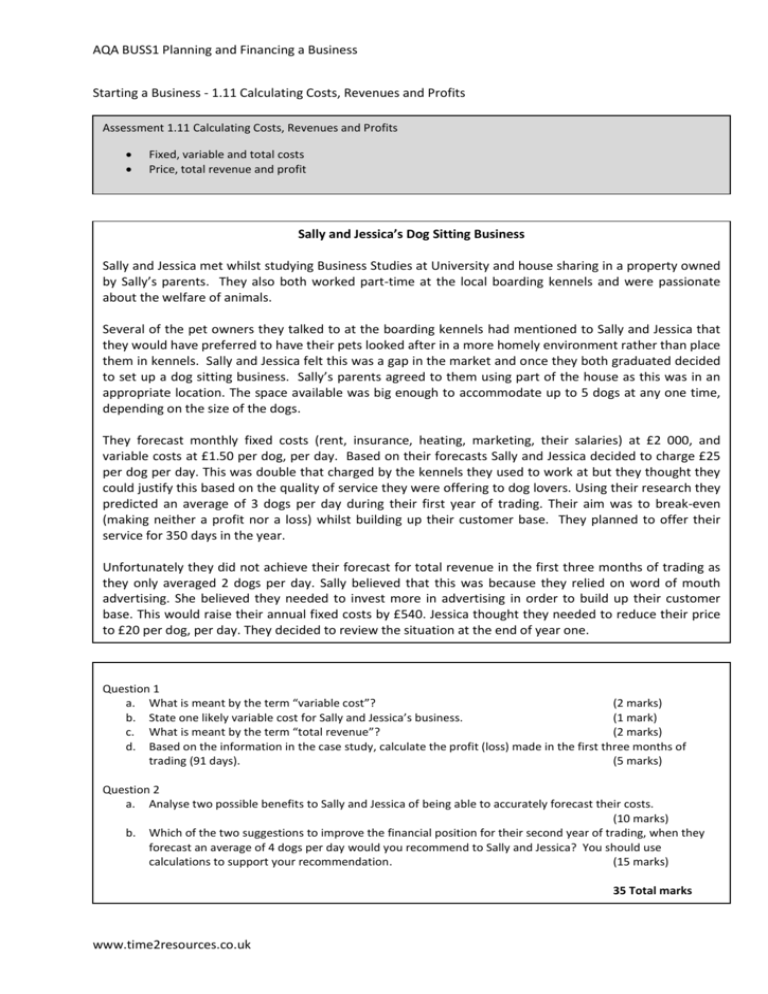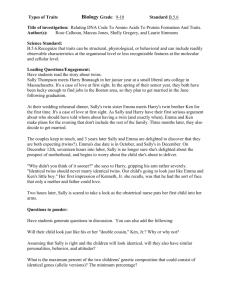File - LPS Business DEPT
advertisement

AQA BUSS1 Planning and Financing a Business Starting a Business - 1.11 Calculating Costs, Revenues and Profits Assessment 1.11 Calculating Costs, Revenues and Profits Fixed, variable and total costs Price, total revenue and profit Sally and Jessica’s Dog Sitting Business Sally and Jessica met whilst studying Business Studies at University and house sharing in a property owned by Sally’s parents. They also both worked part-time at the local boarding kennels and were passionate about the welfare of animals. Several of the pet owners they talked to at the boarding kennels had mentioned to Sally and Jessica that they would have preferred to have their pets looked after in a more homely environment rather than place them in kennels. Sally and Jessica felt this was a gap in the market and once they both graduated decided to set up a dog sitting business. Sally’s parents agreed to them using part of the house as this was in an appropriate location. The space available was big enough to accommodate up to 5 dogs at any one time, depending on the size of the dogs. They forecast monthly fixed costs (rent, insurance, heating, marketing, their salaries) at £2 000, and variable costs at £1.50 per dog, per day. Based on their forecasts Sally and Jessica decided to charge £25 per dog per day. This was double that charged by the kennels they used to work at but they thought they could justify this based on the quality of service they were offering to dog lovers. Using their research they predicted an average of 3 dogs per day during their first year of trading. Their aim was to break-even (making neither a profit nor a loss) whilst building up their customer base. They planned to offer their service for 350 days in the year. Unfortunately they did not achieve their forecast for total revenue in the first three months of trading as they only averaged 2 dogs per day. Sally believed that this was because they relied on word of mouth advertising. She believed they needed to invest more in advertising in order to build up their customer base. This would raise their annual fixed costs by £540. Jessica thought they needed to reduce their price to £20 per dog, per day. They decided to review the situation at the end of year one. Question 1 a. What is meant by the term “variable cost”? (2 marks) b. State one likely variable cost for Sally and Jessica’s business. (1 mark) c. What is meant by the term “total revenue”? (2 marks) d. Based on the information in the case study, calculate the profit (loss) made in the first three months of trading (91 days). (5 marks) Question 2 a. Analyse two possible benefits to Sally and Jessica of being able to accurately forecast their costs. (10 marks) b. Which of the two suggestions to improve the financial position for their second year of trading, when they forecast an average of 4 dogs per day would you recommend to Sally and Jessica? You should use calculations to support your recommendation. (15 marks) 35 Total marks www.time2resources.co.uk







